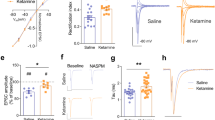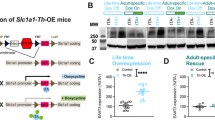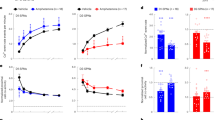Abstract
Amphetamine is a highly addictive psychostimulant that promotes the release of the catecholamines dopamine and norepinephrine. Amphetamine-induced release of dopamine in the midbrain inhibits the activity of dopamine neurons through activation of D2 dopamine autoreceptors. Here we show that amphetamine may also excite dopamine neurons through modulation of glutamate neurotransmission. Amphetamine potently inhibits metabotropic glutamate receptor (mGluR)-mediated IPSPs in dopamine neurons, but has no effect on ionotropic glutamate receptor-mediated EPSCs. Amphetamine desensitizes the mGluR-mediated hyperpolarization through release of dopamine, activation of postsynaptic α1 adrenergic receptors, and suppression of InsP3-induced calcium release from internal stores. By selectively suppressing the inhibitory component of glutamate-mediated transmission, amphetamine may promote burst firing of dopamine neurons. Through this mechanism, amphetamine may enhance phasic release of dopamine, which is important in the neural processing of reward.
This is a preview of subscription content, access via your institution
Access options
Subscribe to this journal
Receive 12 print issues and online access
$259.00 per year
only $21.58 per issue
Buy this article
- Purchase on SpringerLink
- Instant access to full article PDF
Prices may be subject to local taxes which are calculated during checkout






Similar content being viewed by others
References
Fon, E. A., et al. Vesicular transport regulates monoamine storage and release but is not essential for amphetamine action. Neuron 19, 1271–1283 (1997).
Pierce, R. C. & Kalivas, P. W. Repeated cocaine modifies the mechanism by which amphetamine releases dopamine. J. Neurosci. 17, 3254–3261 (1997).
Jones, S. R., Gainetdinov, R. R., Wightman, R. M. & Caron M. G. Mechanisms of amphetamine action revealed in mice lacking the dopamine transporter. J. Neurosci. 18, 1979–1986 (1998).
Amara, S. G. & Sonders, M. S. Neurotransmitter transporters as molecular targets for addictive drugs. Drug Alcohol Depend. 51, 87–96 (1998).
Groves, P. M., Wilson, C. J., Young, S. J. & Rebec, G. V. Self-inhibition by dopaminergic neurons. Science 190, 522–528 (1975).
Mercuri, N. B., Calabresi, P. & Bernardi, G. The mechanism of amphetamine-induced inhibition of rat substantia nigra compacta neurones investigated with intracellular recording in vitro. Br. J. Phamacol. 98, 127–134 (1989).
Pan, W .H., Sung, J. C. & Fuh, S. M. Locally application of amphetamine into the ventral tegmental area enhances dopamine release in the nucleus accumbens and the medial prefrontal cortex through noradrenergic neurotransmission. J. Pharmacol. Exp. Ther. 278, 725–731 (1996).
Darracq, L., Blanc, G., Glowinski, J. & Tassin, J. P. Importance of the noradrenaline–dopamine coupling in the locomotor activating effects of d-amphetamine. J. Neurosci. 18, 2729–2739 (1998).
Shi, W. X., Pun, C. L., Zhang, X. X., Jones, M. D. & Bunney, B. S. Dual effects of d-amphetamine on dopamine neurons mediated by dopamine and nondopamine receptors. J. Neurosci. 20, 3504–3511 (2000).
Jones, S., Kornblum, J. L. & Kauer, J. A. Amphetamine blocks long-term synaptic depression in the ventral tegmental area. J. Neurosci. 20, 5575–5580 (2000).
Grace, A. A. Phasic versus tonic dopamine release and the modulation of dopamine system responsivity: a hypothesis for the etiology of schizophrenia. Neuroscience 41, 1–24 (1991).
Schultz, W. Predictive reward signal of dopamine neurons. J. Neurophysiol. 80, 1–27 (1998).
Overton, P. G. & Clark, D. Burst firing in midbrain dopaminergic neurons. Brain Res. Rev. 25, 312–334 (1997).
Gonon, F. G. Nonlinear relationship between impulse flow and dopamine released by rat midbrain dopaminergic neurons as studied by in vivo electrochemistry. Neuroscience 24, 19–28 (1988).
Suaud-Chagny, M. F., Chergui, K., Chouvet, G. & Gonon, F. Relationship between dopamine release in the rat nucleus accumbens and the discharge activity of dopaminergic neurons during local in vivo application of amino acids in the ventral tegmental area. Neuroscience 49, 63–72 (1992).
Fiorillo, C. D. & Williams, J. T. Glutamate mediates an inhibitory postsynaptic potential in dopamine neurons. Nature 394, 78–82 (1998).
Clausing, P., Gough, B., Holson, R. R., Slikker, W. Jr. & Bower, J. F. Amphetamine levels in brain microdialysate, caudate/putamen, substantial nigra and plasma after dosage that produces either behavioral or neurotoxic effects. J. Pharmacol. Exp. Ther. 274, 614–621 (1995).
Yokel, R. A. & Pickens, R. Drug level of d- and l-amphetamine during intravenous self-administration. Psychopharmacology (Berl.) 34, 255–264 (1974).
Fiorillo, C. D. & Williams, J. T. Selective inhibition by adenosine of mGluR IPSPs in dopamine neurons following cocaine treatment. J. Neurophysiol. 83, 1307–1314 (2000).
Jones, S. & Kauer, J. A. Amphetamine depresses excitatory synaptic transmission via serotonin receptors in the ventral tegmental area. J. Neurosci. 19, 9780–9787 (1999).
Grenhoff, J., North, R. A. & Johnson, S. W. Alpha1-adrenergic effects on dopamine neurons recorded intracellularly in the rat midbrain slice. Eur. J. Neurosci. 7, 1707–1713 (1995).
Ruffolo, R. R. Jr., Goldberg, M. R., & Morgan, E. L. Interactions of epinephrine, noradrenaline, dopamine, and their corresponding alpha-methyl-substituted derivatives with alpha and beta adrenoceptors in the pithed rat. J. Pharmacol. Exp. Ther. 230, 595–600 (1984).
Reader, T. A., Brière, R. & Grondin, L. Alpha-1 and alpha-2 adrenoceptor binding in cerebral cortex: competition studies with [3H]prazocin and [3H]idazoxan. J. Neural Transm. 68, 79–95 (1987).
Morikawa, H., Imani, F., Khodakhah, K. & Williams, J. T. Inositol 1,4,5-triphosphate-evoked responses in midbrain dopamine neurons. J. Neurosci. 20, RC103 1–5 (2000).
Guatteo, E., Mercuri, N. B., Bernardi, G. & Knopfel, T. Group I metabotropic glutamate receptors mediate an inward current in rat substantia nigra dopamine neurons that is independent from calcium mobilization. J. Neurophysiol. 82, 1974–1981 (1999).
Scarponi, M., Bernardi, G. & Mercuri, N. B. Electrophysiological evidence for a reciprocal interaction between amphetamine and cocaine-related drugs on rat midbrain dopaminergic neurons. Eur. J. Neurosci. 11, 593–598 (1999).
Grenhoff, J., Nisell, M., Ferre, S., Aston-Jones, G. & Svensson, T. H. Noradrenergic modulation of midbrain dopamine cell firing elicited by stimulation of the locus coeruleus in the rat. J. Neural Transm. Gen. Sect. 93, 11–25 (1993).
Nicola, S. M., Kombian, S. B. & Malenka, R. C. Psychostimulants depress excitatory synaptic transmission in the nucleus accumbens via presynaptic D1-like dopamine receptors. J. Neurosci. 16, 1591–1604 (1996).
Harvey, J. & Lacey, M. G. Endogenous and exogenous dopamine depress EPSCs in rat nucleus accumbens in vitro via D1 receptor activation. J. Physiol. (Lond.) 492, 143–154 (1996).
Travagli, R. A. & Williams, J. T. Endogenous monoamines inhibit glutamate transmission in the spinal trigeminal nucleus of the guinea-pig. J. Physiol. (Lond.) 491, 177–185 (1996).
Fiorillo, C. D. & Williams, J. T. Cholinergic inhibition of ventral midbrain dopamine neurons. J. Neurosci. 20, 7855–7860 (2000).
Hajnoczky, G. & Thomas, A. P. The inositol trisphosphate calcium channel is inactivated by inositol trisphosphate. Nature 370, 474–477 (1994).
Grace, A. A. & Bunney, B. S. The control of firing pattern in nigral dopamine neurons: burst firing. J. Neurosci. 11, 2877–2890 (1984).
Marinelli, M. & White, F. J. Enhanced vulnerability to cocaine self-administration is associated with elevated impulse activity of midbrain dopamine neurons. J. Neurosci. 20, 8876–8885 (2000).
Thomas, M. J., Malenka, R. C. & Bonci, A. Modulation of long-term depression by dopamine in the mesolimbic system. J. Neurosci. 20, 5581–5586 (2000).
Blanc, G. et al. Blockade of prefronto-cortical alpha 1-adrenergic receptors prevents locomotor hyperactivity induced by subcortical D-amphetamine injection. Eur. J. Neurosci. 6, 293–298 (1994).
Dickinson, S. L., Gadie, B. & Tulloch, I. F. Alpha 1- and alpha 2-adrenoreceptor antagonists differentially influence locomotor and stereotyped behaviour induced by d-amphetamine and apomorphine in the rat. Psychopharmacology (Berl.) 96, 521–527 (1988).
Mavridis, M., Colpaert, F. C. & Millan, M. J. Differential modulation of (+)-amphetamine-induced rotation in unilateral substantia nigra lesioned rats by alpha 1 as compared to alpha 2 agonists and antagonists. Brain Res. 562, 216–224 (1991).
Poncelet, M., Chermat, R., Soubrie, P. & Simon, P. The progressive ratio schedule as a model for studying the psychomotor stimulant activity of drugs in the rat. Psychopharmacology (Berl.) 80, 184–189 (1983).
Snoddy, A. M. & Tessel, R. E. Prazosin: effect on psychomotor-stimulant cues and locomotor activity in mice. Eur. J. Pharmacol. 116, 221–228 (1985).
Tessel, R. E. & Barrett, J. E. Antagonism of the behavioral effects of cocaine and d-amphetamine by prazosin. Psychopharmacology (Berl.) 90, 436–440 (1986).
Grenhoff, J. & Svensson, T. H. Prazosin modulates the firing pattern of dopamine neurons in rat ventral tegmental area. Eur. J. Pharmacol. 233, 79–84 (1993).
Williams, J. T., North, R. A., Shefner, S. A., Nishi, S. & Egan, T. M. Membrane properties of rat locus coeruleus neurones. Neuroscience 13, 137–56 (1984).
Johnson, S. W. & North, R. A. Two types of neurone in the rat ventral tegmental area and their synaptic inputs. J. Physiol.(Lond.) 450, 455–468 (1992).
Acknowledgements
We thank K. Khodakhah for instruction and guidance in the flash photolysis experiments, and O. Manzoni for comments on the work and manuscript. This work was supported by NIH grants DA04523 (J.T.W.), DA05793 (C.D.F.) and DA07262 (C.A.P.).
Author information
Authors and Affiliations
Corresponding author
Rights and permissions
About this article
Cite this article
Paladini, C., Fiorillo, C., Morikawa, H. et al. Amphetamine selectively blocks inhibitory glutamate transmission in dopamine neurons. Nat Neurosci 4, 275–281 (2001). https://doi.org/10.1038/85124
Received:
Accepted:
Issue date:
DOI: https://doi.org/10.1038/85124
This article is cited by
-
In vivo patch-clamp recordings reveal distinct subthreshold signatures and threshold dynamics of midbrain dopamine neurons
Nature Communications (2020)
-
Cocaine Increases Dopaminergic Neuron and Motor Activity via Midbrain α1 Adrenergic Signaling
Neuropsychopharmacology (2015)
-
Alpha-1 Adrenergic Receptors are Localized on Presynaptic Elements in the Nucleus Accumbens and Regulate Mesolimbic Dopamine Transmission
Neuropsychopharmacology (2012)
-
Mechanisms underlying the onset and expression of levodopa-induced dyskinesia and their pharmacological manipulation
Journal of Neural Transmission (2011)
-
α1-Adrenergic Receptor-Induced Heterosynaptic Long-Term Depression in the Bed Nucleus of the Stria Terminalis Is Disrupted in Mouse Models of Affective Disorders
Neuropsychopharmacology (2008)



